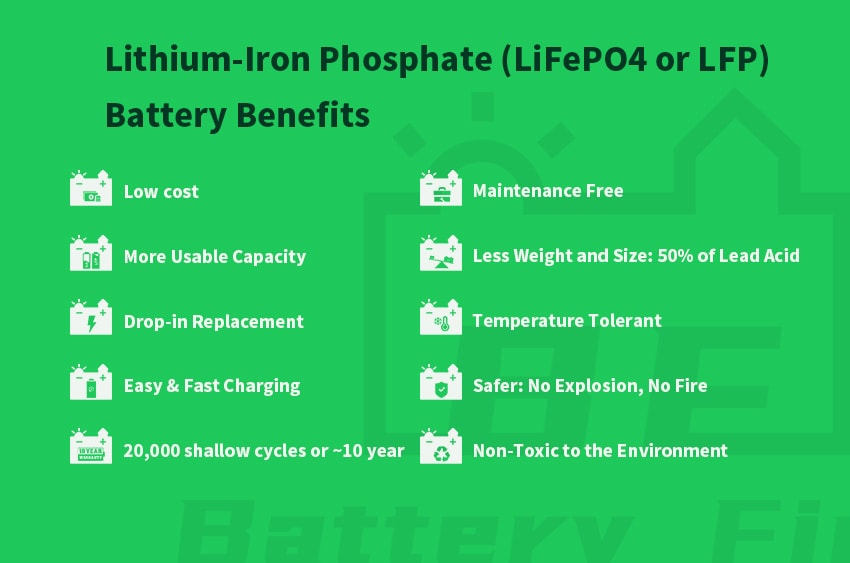The lithium battery pack is a new battery that has been approved by the public in recent years to extend battery life. As the positive electrode material of lithium batteries, lithium iron phosphate is the safest cathode material for lithium-ion batteries. Due to its safety and stability, the lifepo4 battery has become an important development direction of the lithium-ion battery.
Next, Battery Finds will explain the advantages of the LiFePO4 battery pack compared with the lead-acid battery from the following directions:
Cost
The one category in which lead acid batteries seemingly outperform lithium-ion options is in their cost. While lead acid batteries typically have lower purchase and installation costs compared to lithium-ion options, the lifetime value of a lithium-ion battery evens the scales.
While lithium batteries have higher up-front costs, their superior efficiency means potentially lower costs per kilowatt/hour of capacity over the lifespan of the battery.
Capacity
The lithium-ion battery technology has been well-proven to have a significantly higher energy density than lead-acid batteries. This means that more energy can be stored in a lithium-ion battery using the same physical space. Because you can store more energy with lithium-ion technology, you can discharge more energy, thus power more appliances for longer periods of time.
Depth of Discharge (DOD)
Like we’ve just discussed, the depth of discharge refers to how much of the battery’s capacity is used before it’s recharged. For instance, if half of a battery’s capacity is used, the depth of discharge would be 50%.
With lead-acid batteries, it’s generally recommended that they should not be run to a depth of discharge any higher than 50%. Discharging the battery beyond that can negatively affect its lifespan.
Lithium-ion batteries, on the other hand, can easily handle deep discharges of 80% or more, which means that they have a higher usable capacity.
Higher efficiency translates into faster charging times. Depending on your system’s configurations, it could also mean you purchasing fewer solar panels and a smaller backup generator.
Efficiency
Most lithium-ion batteries are 95 percent efficient or more, meaning that 95 percent or more of the energy stored in a lithium-ion battery is actually able to be used. Conversely, lead-acid batteries see efficiencies closer to 80 to 85 percent. Higher efficiency batteries charge faster, and similarly to the depth of discharge, improved efficiency means a higher effective battery capacity.
Lifespan
Lithium iron phosphate batteries (LiFePO4) have a life span 10 times longer than that of traditional lead-acid batteries, resulting in fewer costs per kilowatt-hour. This dramatically reduces the need for battery changes.
Maintenance
Lead acid batteries require a considerable amount of upkeep (but may not always) .
- Topping up the batteries with distilled water
- Checking and cleaning the battery terminals to prevent corrosion
- Ensuring the batteries are well ventilated
- Inspecting your battery cables and connections
- Monitoring (and maintaining) the battery state of charge to prevent sulfation
Size & Weight
LifeP04 battery provides twice the battery capacity in the same amount of space.
Lead-acid requires an upright position while lithium can be stored any way you want…on its side, on its back, even vertically. More flexibility makes room for more space.
LifeP04 batteries (72 lbs.) weigh just 1/4 the weight of traditional Lead-Acid batteries (325 lbs.).
This major weight reduction will make your cart faster, more “fuel” (battery) efficient, and increases your ride height a bit (from ½ inch to 1 inch).
LiFePO4 battery will make your cart faster, more “fuel” (battery), increases your ride heights a bit. And LiFePo4 battery not only allows your boat to travel more smoothly, but it’ll also save you a lot in fuel costs.
Performance
Perhaps you’re concerned about the longevity of your battery in extreme temperatures. Whether your battery’s in use or stored, one option fares far better with extreme temperatures. Lead-acid batteries are easily damaged by high and low temperatures. When exposed to temperatures over or under 77 degrees Fahrenheit, they lose their capacity by up to 50%. And that’s only after a few hours. Lithium batteries won’t see a decrease in performance until temperatures reach over 120 degrees Fahrenheit. And even then, the decrease in performance will only be around 20%.
Safety
Lithium is considered one of the safest batteries on the market and is easy to use and store without concern. Lead-acid is considered safe as well, but they do require a ventilation system making their upkeep and storage more difficult.
Environmental Impact & Recycling
Lead-acid battery: Contains heavy metals such as lead and antimony, which cause serious pollution to the environment. It is prone to leakage due to use and maintenance. Internal sulfuric acid spillage causes equipment corrosion and personal injury.
LiFePO4 battery: Lithium iron phosphate material does not contain any heavy metals and rare metals, non-toxic, no pollution in production and use, in line with European RoHS regulations, is a green battery lithium battery. In experiments such as puncture, extrusion, overcharging, and short circuits, it does not explode or ignite.
In summary, lithium batteries are certainly making a strong case to become the new standard in home battery storage – at least at some point. With a smaller size, higher efficiency, and a greater depth of discharge, lithium offers advantages in virtually every area except for the up-front price.


So you are saying your Lithium batteries can last 120 years?
My forklift battery only lasted 12 years, though expected life could be 15-20 years (mine was poisoned)
Obviously, they can’t take up as little space inside, since Lead acid don’t need to be kept warm or inside in most climates.